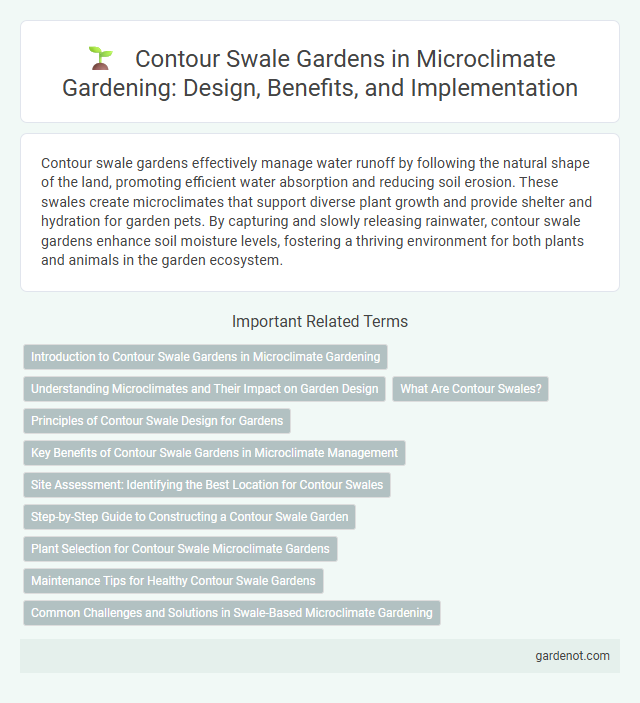Contour swale gardens effectively manage water runoff by following the natural shape of the land, promoting efficient water absorption and reducing soil erosion. These swales create microclimates that support diverse plant growth and provide shelter and hydration for garden pets. By capturing and slowly releasing rainwater, contour swale gardens enhance soil moisture levels, fostering a thriving environment for both plants and animals in the garden ecosystem.
Introduction to Contour Swale Gardens in Microclimate Gardening
Contour swale gardens are trenches dug along the natural contours of a landscape designed to capture and store rainwater, promoting soil moisture retention and reducing erosion in microclimate gardening. These swales enhance water infiltration by slowing runoff, creating localized zones of increased humidity and cooler temperatures that benefit plant growth. Implementing contour swale gardens supports sustainable water management and improves microclimatic conditions for diverse vegetation.
Understanding Microclimates and Their Impact on Garden Design
Contour swale gardens strategically harness microclimates by following land contours to capture water and improve soil moisture retention, creating favorable conditions for plant growth. These swales modify temperature, humidity, and wind flow in microclimates, enhancing garden resilience and productivity. Understanding the impact of terrain, sun orientation, and water movement in microclimates is crucial for optimizing swale placement and maximizing ecological benefits.
What Are Contour Swales?
Contour swales are shallow, water-harvesting trenches dug along the natural contours of a landscape to slow runoff and increase water infiltration. These swales help reduce soil erosion, improve groundwater recharge, and support microclimate garden health by maintaining consistent moisture levels. Designed to follow the land's topography precisely, contour swales optimize water retention and create favorable growing conditions for diverse plant species.
Principles of Contour Swale Design for Gardens
Contour swale gardens utilize earthworks constructed along natural land contours to capture and infiltrate rainwater, enhancing soil moisture and reducing erosion. Proper design principles include aligning swales with contour lines to maintain level basins, ensuring gradual water flow and preventing runoff. Incorporating berms and overflow spillways supports water management while promoting healthy plant growth in microclimate garden environments.
Key Benefits of Contour Swale Gardens in Microclimate Management
Contour swale gardens effectively capture and retain rainwater, reducing soil erosion and enhancing groundwater recharge in microclimate zones. These earthworks create natural moisture barriers that promote healthy plant growth and increase biodiversity by supporting diverse microhabitats. Improved water infiltration and soil stability contribute to cooler ambient temperatures, making contour swale gardens a sustainable solution for microclimate management.
Site Assessment: Identifying the Best Location for Contour Swales
Site assessment for contour swale gardens involves analyzing slope gradient, soil type, and water flow patterns to determine the optimal placement. Identifying natural contours and topographical high points ensures effective water capture and prevents erosion. Evaluating sun exposure and existing vegetation further refines the location to support microclimate benefits and plant health.
Step-by-Step Guide to Constructing a Contour Swale Garden
Creating a contour swale garden involves mapping the natural slope of your land to capture and retain rainwater effectively, promoting soil moisture and reducing erosion. Begin by identifying the contour lines using an A-frame level or laser level, then dig shallow, elongated trenches along these lines to form swales. Enhance the swales by planting native drought-tolerant species, which thrive with the harvested water and improve soil health within your microclimate garden.
Plant Selection for Contour Swale Microclimate Gardens
Selecting drought-tolerant native plants and deep-rooted perennials is essential for contour swale microclimate gardens, as these species optimize water absorption and reduce soil erosion. Incorporating a mix of nitrogen-fixing plants like clover and dynamic accumulators such as comfrey enhances soil fertility and supports healthy micro-ecosystems. Choosing plants adapted to local sun exposure and moisture gradients within the swale ensures maximum growth efficiency and microclimate stability.
Maintenance Tips for Healthy Contour Swale Gardens
Regularly clearing debris and managing vegetation in contour swale gardens prevents erosion and promotes efficient water absorption. Monitoring soil moisture levels helps maintain optimal hydration without waterlogging, supporting plant health and growth. Periodic inspection of swale contours ensures structural integrity, enhancing water retention and minimizing runoff in microclimate garden systems.
Common Challenges and Solutions in Swale-Based Microclimate Gardening
Contour swale gardens often face challenges such as soil erosion, waterlogging, and uneven water distribution, which can hinder plant growth and reduce microclimate effectiveness. Implementing infiltration trenches, proper grading, and mulching helps control erosion and maintain optimal moisture levels. Strategic placement of native drought-tolerant plants improves water absorption and stabilizes soil in swale systems.
Contour swale garden Infographic

 gardenot.com
gardenot.com